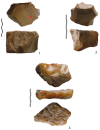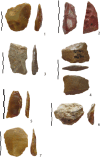Earliest evidence of human occupations and technological complexity above the 45th North parallel in Western Europe. The site of Lunery-Rosieres la-Terre-des-Sablons (France, 1.1 Ma)
- PMID: 39043764
- PMCID: PMC11266561
- DOI: 10.1038/s41598-024-66980-4
Earliest evidence of human occupations and technological complexity above the 45th North parallel in Western Europe. The site of Lunery-Rosieres la-Terre-des-Sablons (France, 1.1 Ma)
Erratum in
-
Correction: Earliest evidence of human occupations and technological complexity above the 45th North parallel in Western Europe. The site of Lunery-Rosieres la-Terre-des-Sablons (France, 1.1 Ma).Sci Rep. 2025 May 27;15(1):18553. doi: 10.1038/s41598-025-00671-6. Sci Rep. 2025. PMID: 40425611 Free PMC article. No abstract available.
Abstract
The site of LuneryRosieres la-Terre-des-Sablons (Lunery, Cher, France) comprises early evidence of human occupation in mid-latitudes in Western Europe. It demonstrates hominin presence in the Loire River Basin during the Early Pleistocene at the transition between an interglacial stage and the beginning of the following glacial stage. Three archaeological levels sandwiched and associated with two diamicton levels deposited on the downcutting river floor indicate repeated temporary occupations. Lithic material yields evidence of simple and more complex core technologies on local Jurassic siliceous rocks and Oligocene millstone. Hominins availed of natural stone morphologies to produce flakes with limited preparation. Some cores show centripetal management and a partially prepared striking platform. The mean ESR age of 1175 ka ± 98 ka obtained on fluvial sediments overlying the archaeological levels could correspond to the transition between marine isotopic stages (MIS) 37 and 36, during the normal Cobb Mountain subchron, and in particular at the beginning of MIS 36. The Lunery site shows that hominins were capable of adapting to early glacial environmental conditions and adopting appropriate strategies for settling in mid-latitude zones. These areas cannot be considered as inhospitable at that time as Lunery lies at some distance from the forming ice cap.
Keywords: Early hominin occupations; Early pleistocene; Lunery; Raw materials; Technology; Western Europe.
© 2024. The Author(s).
Conflict of interest statement
The authors declare no competing interests.
Figures









Similar articles
-
Correction: Earliest evidence of human occupations and technological complexity above the 45th North parallel in Western Europe. The site of Lunery-Rosieres la-Terre-des-Sablons (France, 1.1 Ma).Sci Rep. 2025 May 27;15(1):18553. doi: 10.1038/s41598-025-00671-6. Sci Rep. 2025. PMID: 40425611 Free PMC article. No abstract available.
-
Tracking behavioral persistence and innovations during the Middle Pleistocene in Western Europe. Shift in occupations between 700 and 450 ka at la Noira site (Centre, France).J Hum Evol. 2021 Jul;156:103009. doi: 10.1016/j.jhevol.2021.103009. Epub 2021 May 25. J Hum Evol. 2021. PMID: 34049270
-
Early evidence of Acheulean settlement in northwestern Europe--la Noira site, a 700,000 year-old occupation in the center of France.PLoS One. 2013 Nov 20;8(11):e75529. doi: 10.1371/journal.pone.0075529. eCollection 2013. PLoS One. 2013. PMID: 24278105 Free PMC article.
-
The Paleolithic in the Nihewan Basin, China: Evolutionary history of an Early to Late Pleistocene record in Eastern Asia.Evol Anthropol. 2020 May;29(3):125-142. doi: 10.1002/evan.21813. Epub 2019 Dec 20. Evol Anthropol. 2020. PMID: 31859441 Review.
-
Possible paleohydrologic and paleoclimatic effects on hominin migration and occupation of the Levantine Middle Paleolithic.J Hum Evol. 2011 Apr;60(4):437-51. doi: 10.1016/j.jhevol.2010.03.010. Epub 2010 Jun 11. J Hum Evol. 2011. PMID: 20541789 Review.
Cited by
-
Homo sapiens adapted to diverse habitats before successfully populating Eurasia.Nature. 2025 Aug;644(8075):44-46. doi: 10.1038/d41586-025-01710-y. Nature. 2025. PMID: 40533586 No abstract available.
References
-
- Zhu, Z. et al. Hominin occupation of the Chinese Loess Plateau since about 2.1 million years ago. Nature559(7715), 608–612 (2018). - PubMed
-
- Peretto, C. et al. L’industrie lithique de Cà Belvedere di Monte Poggiolo: stratigraphie, matière première, typologie, remontages et traces d’utilisation. L’Anthr.102(4), 343–465 (1998).
-
- Messager, E., Lordkipanidze, D., Delhon, C. & Ferring, C. R. Palaeoecological implications of the Lower Pleistocene phytolith record from the Dmanisi Site (Georgia). Palae. Palae. Palaeoecol.288(1–4), 1–13 (2010).
-
- Arzarello, M., Peretto, C. & Moncel, M. H. The Pirro Nord site (Apricena, Fg, Southern Italy) in the context of the first European peopling: Convergences and divergences. Quat. Int.389, 255–263 (2015).
Publication types
MeSH terms
Grants and funding
LinkOut - more resources
Full Text Sources
Miscellaneous

